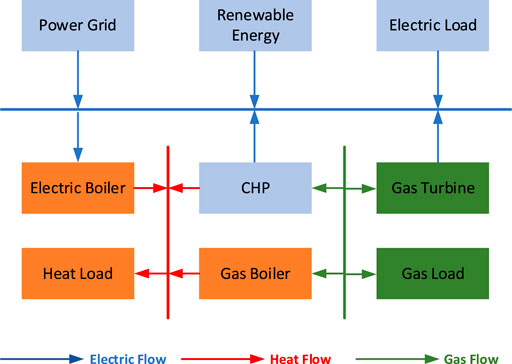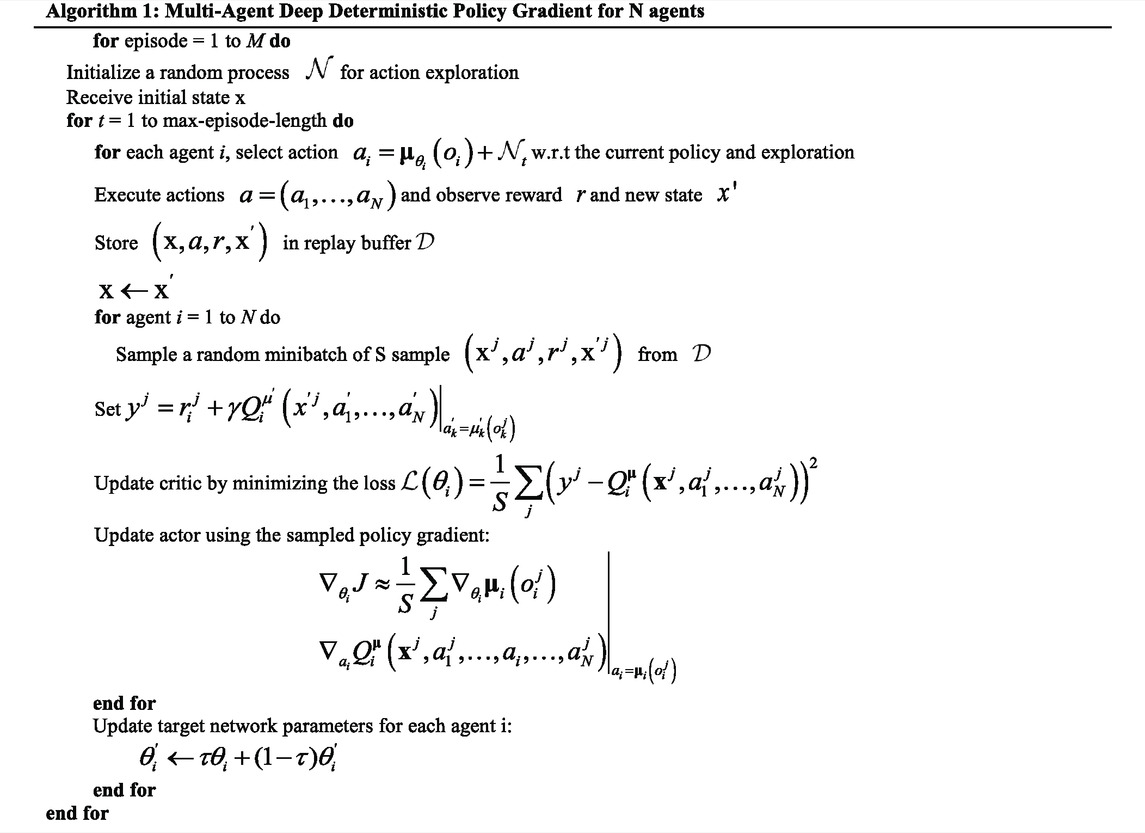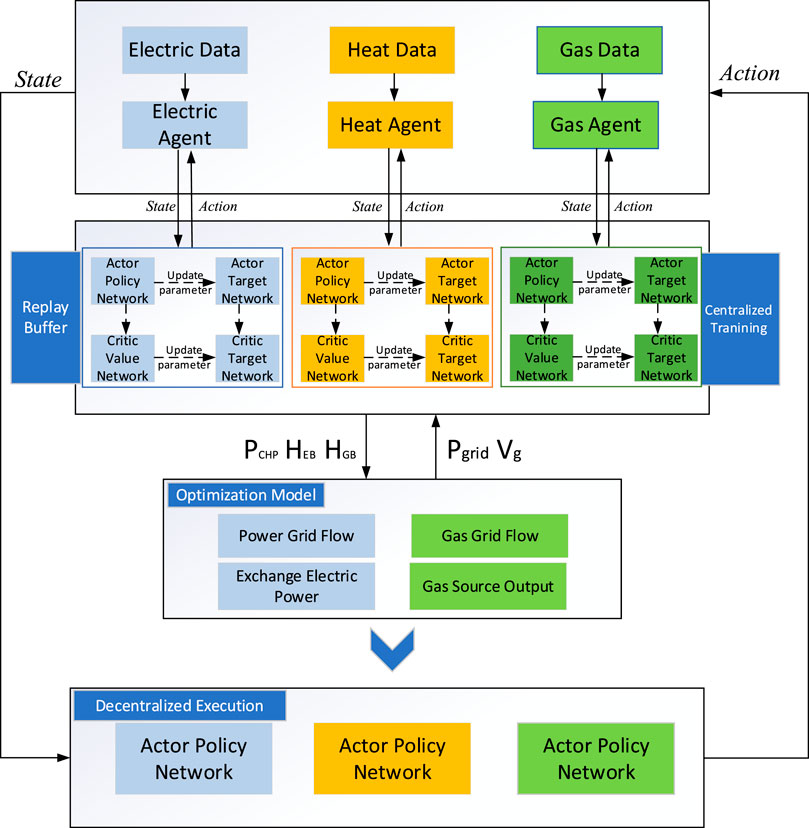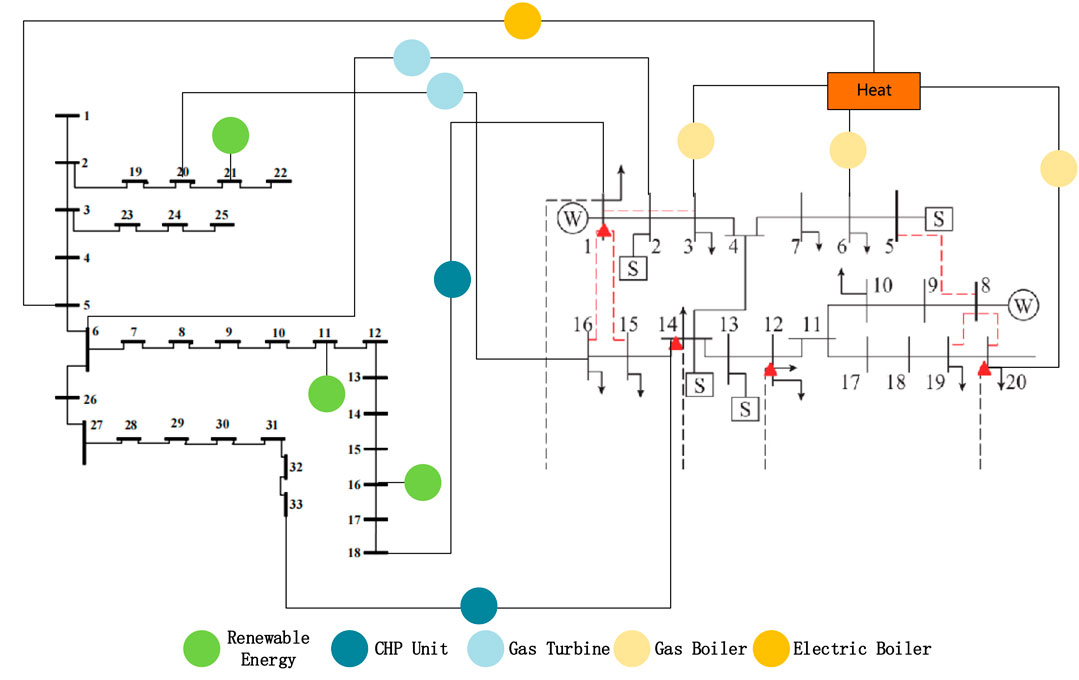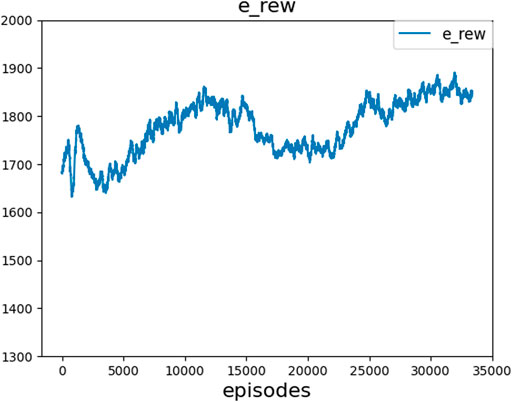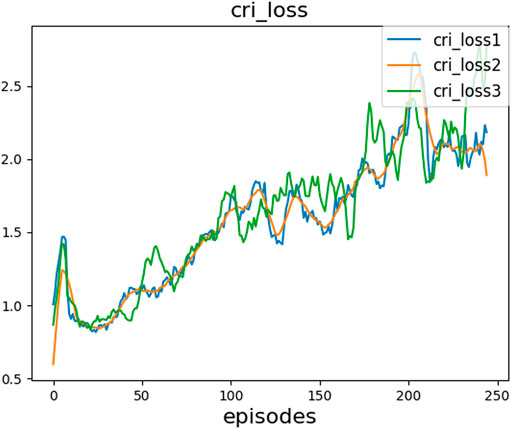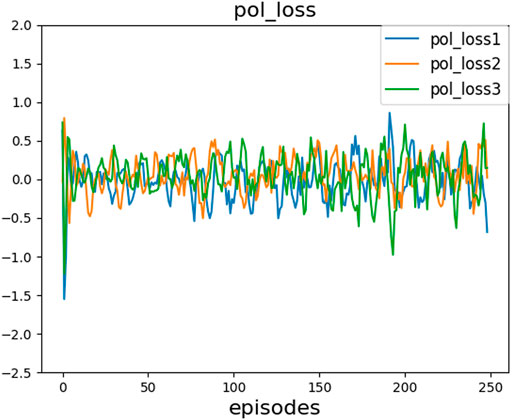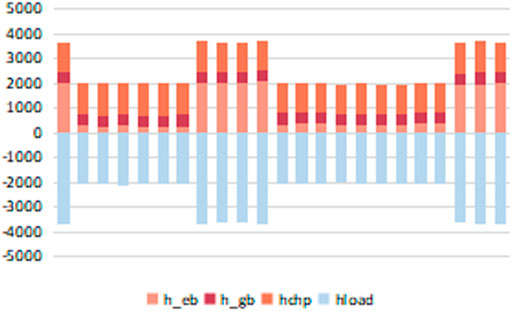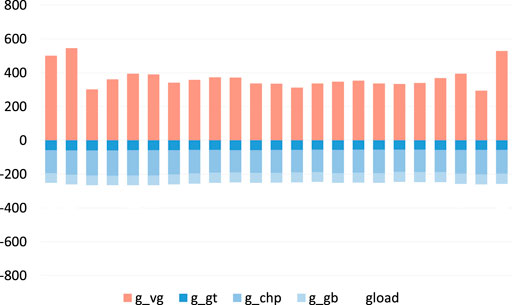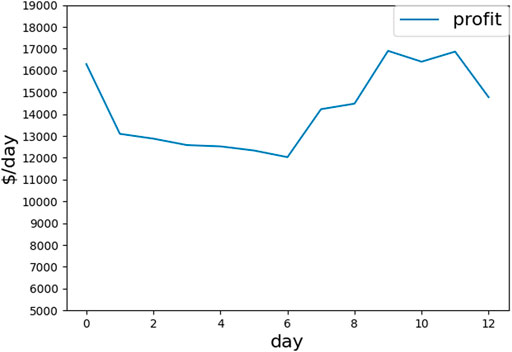Coordinated Control Strategy of Electricity-Heat-Gas Integrated Energy System Considering Renewable Energy Uncertainty and Multi-Agent Mixed Game
- 1State Grid Hubei Electric Power Co., Ltd., Wuhan, China
- 2State Grid Hubei Electric Power Co., Ltd., Economic and Technological Research Institute, Wuhan, China
- 3School of Electrical and Automation, Wuhan University, Wuhan, China
The Integrated Energy System (IES) can promote social energy transformation and low-carbon development, which is also an effective means to make contributions to energy structure optimization, energy consumption reduction, and new energy consumption. However, the IES has the characteristics of complex energy flow, and strong uncertainty with multi-agents. Therefore, traditional mathematical optimization models are difficult to comprehensively and accurately reflect the interest needs of different entities in the integrated energy microgrid. Aiming at this problem, a two-level collaborative control strategy model of “electricity-heat-gas” IES based on multi-agent deep reinforcement learning is proposed in this paper. The upper layer of this model is a multi-agent hybrid game decision-making model based on the Multi-Agent Deep Deterministic Policy Gradient algorithm (MADDPG), and the lower layer contains the power and gas flow calculation model. The lower model provides the upper model with the energy flow data of the IES and the upper layer rewards the decision-making behavior of the agent based on the energy flow data provided by the lower layer. Effectively solving the high-dimensional nonlinear optimization problem existing in the complex coupling network, this method can improve the convergence and training speed of the model. In this paper, the IEEE 33-node distribution network and 20-node gas network coupling system are provided to verify the model. The simulation results show that the proposed collaborative control strategy method can provide effective decision-making for electric-agent and gas-agent and realize the efficient and economic operation of the integrated energy system.
1 Introduction
With the trend of low-carbon, cleanness and sustainability of electric industry going further, the energy structure of all countries in the world is gradually realizing electric energy substitution and clean energy substitution. China’s “carbon peaking and carbon neutrality (dual carbon)” goals are also important to the international community (Ali et al., 2021). Effective response to green and low-carbon development. The Integrated Energy System (IES) runs through the coordinated operation of electric and thermal energy, which can effectively improve energy utilization, and is of great significance for promoting the consumption of renewable energy and achieving the “dual carbon” goal (Mohamed, 2022). On the energy side, wind power, photovoltaic, natural gas and other clean energy access the grid and will increase the uncertainty of power supply, heating and other aspects (Rezaei et al., 2021; Xia et al., 2021). Meanwhile, on the load side, new types of loads such as electric vehicles, smart homes and other forms of energy loads can deeply participate in energy interactions and also increase new uncertainties in the demand side (Al-Ghussain et al., 2021; Lan et al., 2021). Moreover, the integrated energy system integrates coal, oil, natural gas, electricity, heat and other energy sources in the region (Tan et al., 2022). At the same time, the existing market investment body is increasing. This means that in the existing market environment in China, grid companies have changed from being the dominant player in the construction of energy networks to being an important player in the construction of energy networks (Sun et al., 2015; Ma et al., 2021). Unlike the traditional integrated energy synergy from the overall perspective of decision-making, the integrated energy system is oriented to multiple competing subjects, and there is a significant game relationship between different subjects (Weinstein, 2010). In this background, it is important to study and propose an integrated energy system control strategy that takes into account the game relationship of diverse investment agents.
The problem of integrated energy system regulation has been studied by scholars in China and abroad and certain results have been achieved (Abdelaziz Mohamed and Eltamaly, 2018a). In order to solve the energy station-grid configuration problem, Huang Wei et al. (Huang and Liu, 2020) proposed an integrated energy station-grid double-layer planning optimization model for parks considering the multi-energy complementary characteristics of energy stations. The model effectively alleviates the problem of under-supply or over-supply caused by zonal supply and peak-to-valley demand. The authors in (Yao and Wang, 2020) propose a two-level collaborative optimal allocation method for integrated energy systems considering wind and solar uncertainty. The approach improves both total annualized system cost and average annual equipment utilization. The article verifies the effectiveness and economy of the proposed method. Walter et al. (2020) proposed the integration of thermal energy systems into microgrid energy management systems. He builds models based on consideration of fuel costs, thermal comfort and other factors. Moreover, its economic efficiency is fully considered the optimal solution to achieve the purpose of reducing the cost of electricity and heating. All of the above literature uses a game theory and traditional centralized method approach to regulate aspects such as power system generation, and grid structure. The disadvantage of above approach is that it is difficult to allocate the power system dynamically and also having the problem of solving quickly.
It is worth noting the close coupling of different energy networks such as electricity and natural gas in the integrated energy system (Abdelaziz Mohamed and Eltamaly, 2018b). The problem of solving control strategies for integrated energy systems is a nonlinear, non-convex optimization problem. Therefore, it is difficult to solve the problem by relying only on traditional mathematical modeling methods (Mohamed et al., 2020).
In recent years, Reinforce Learning (RL) has made significant breakthroughs in data resolution, learning power and computational power. RL has been applied to smart manufacturing, smart medical and other fields. In terms of application results, it has shown good application effects (Sutton and Barto, 1998; Leo Kumar, 2017; Park and Han, 2018). Nowadays, some researchers have applied multi-agent and game theory to energy power systems. These researches make use of the characteristics of multi-agent such as autonomy, interactivity and distributed computing properties and analyze the interesting pursuit of different agents and the possible interest equilibrium relationship through game theory for economic scheduling and energy management (Makhadmeh et al., 2021). In (Yang et al., 2021), a dynamic economic dispatch for integrated energy systems based on the DDPG algorithm was proposed. And this method can achieve dynamic economic scheduling of the system better than traditional methods, but this mechanism uses uniform random sampling to extract empirical data from the experience pool without considering the importance of different experiences. The authors in (Nie et al., 2021) proposed a double-layer reinforcement learning model to achieve real-time economic dispatch of IES with higher solving efficiency. The authors in (Liu et al., 2019) divide the microgrid system into multi-agent, establishes a multi-agent game coordination scheduling model, and proposes an integrated energy microgrid scheduling method based on the Nash game and Q-learning algorithm. However, this model does not take into account the end-load demand. In (Qiao et al., 2021), the authors present a deep reinforcement learning approach based on a soft actor-critic framework for the problem of optimizing the operation of integrated electricity-gas energy systems. The method can realize the continuous action control of a multi-energy flow system, and can flexibly handle the source-load uncertainty of wind power, photovoltaic, multi-energy load, etc. However, the thermal energy in the integrated energy system is not considered. In (Liu et al., 2020), an energy management and optimization method for micro-energy networks based on deep reinforcement learning is proposed. The method uses an experience replay mechanism and fixed network parameters mechanism, which effectively solves the problems of difficult modeling of integrated energy systems, slow convergence of traditional algorithm operation and difficulty in meeting real-time optimization requirements as well as system openness. Reference (Ying et al., 2019) proposes a new energy management approach for real-time dispatch considering load demand, renewable energy and tariff uncertainty. The method adaptively adjusts based on trends in marginal prices and netload, and develops cost-effective dispatch schemes for microgrids in uncertain environments. Reference (Nie et al., 2021) combines deep reinforcement learning with a realistic peer-to-peer (P2P) energy trading model to solve the decision-making problem for microgrids in local energy markets. This strategy improves microgrid utilization and uses virtual penalties to reduce inefficient power plant generation points and to determine the optimal battery capacity for the microgrid. However, there are few studies on integrated energy systems with electricity, heat and gas as the main game (Fan et al., 2021). In the case that all three energy subjects can provide energy in the Integrated Energy System, further research is needed on how to rationally allocate energy to reduce the cost and energy waste of the Integrated Energy System, improve the energy utilization rate, and meet the energy supply and demand and the interest game behavior of the three subjects while responding to the low-carbon economy.
Aiming at the difficulty solving problem of the traditional modelling methods are difficult to solve the problem, this paper model the multi-agent game process, applies DRL to the multi-agent game process of IES, and simulates the multi-agent systemization based on the MADRL algorithm, which at the same time, may contribute to further reduce the cost of the Integrated Energy System, optimize the energy efficiency and meet the daily load. To be specific, considering the game relationship of diversified investment entities in the IES, this article takes the electric-heat-gas integrated energy system as the object and constructs a multi-agent strategy model based on DRL. The main contributions of this article are as follows:
(1) Considering different kinds of energy equipment and their coupling relations in the integrated energy system, the mathematical model of the integrated energy system is constructed;
(2) Based on the theory of DRL, the dynamic game process and decision model of interests multi-energy players of electricity, heat and gas are constructed according to the decisions of different players and their respective benefits;
(3) A two-layer model is established. The lower layer decides the output of electricity, heat and gas networks, and the upper layer model calculates the equilibrium output of the Integrated Energy System based on the output decision of the lower layer and the constraints of multi-power flow;
(4) The reliability and validity of the proposed model is proved by the analysis of calculation examples.
The rest of this paper is organized as follows. Section 2 introduced the structure of Integrated Energy System and multi-agent game theory; In Section 3, mathematical model of Integrated Energy System is discussed in detail, including the constraints. In Section 4, the two-lavel model is introduced and proposed the setting method to a DRL model; Section 5 presents the numerical simulation results. Finally, conclusions and suggestions for future work are drawn in Section 5
2 Integrated Energy System Structure and Multi-Agent Game
In this paper, the IES is constructed by combining electricity/gas/heat energy sources. It is based on a typical industrial park and includes Renewable Energy (RE) Combined Heat and Power (CHP), Gas Turbine (GT), Gas Boiler (GB), Electric Boiler (EB) and other equipment. The system structure is shown in Figure 1.
2.1 Integrated Energy System Structure
In this integrated energy park system, electricity and natural gas can be purchased from external sources; Conversion between electricity and gas can be done by combined heat and power units and gas turbines; Conversion between electricity and heat through combined heat and power units and electric boilers; Conversion between heat and gas via combined heat and power units and gas boilers.
On this basis, this paper takes the three networks that exist in the system as different subjects of interest. The structure divides IES into three investment entities: electricity (main grid, renewable energy, combined heat and power units), heat (gas boilers, electric boilers) and natural gas.
2.2 Multi-Agent Game Model
This section analyzes the control problem of multi-energy synergy within an integrated energy system and constructs a hybrid game Markov process for electrical and thermal multi-subjects. The structure can fully consider the interests of different subjects and avoids the dimensional catastrophe in the state and action space that arises when deep reinforcement learning is applied.
In this paper, the Nash equilibrium point of solving the game between multiple agents is used as a control strategy for integrated energy systems. Its target expression is
Where,
3 Mathematical Model of Integrated Energy System Control Strategy
The three investment entities included in the actual IES: electricity, natural gas and heat. These three investment entities will consider their interests more in the operation process. Traditional optimization methods are difficult to solve optimally for the game relationship between the three entities and to minimize the operating cost of the system. Therefore, this section considers the return of the investment subject based on the intelligent body division method proposed in Section 2. And the control strategy revenue model of electric, natural gas and thermal energy investment entities is constructed.
3.1 Objective Function
The control objective of this system is to maximize the net profit of its system over a period of T by controlling the output of controllable equipment. The system is set to T for 24 h and the net profit of IES is the operating revenue minus the investment cost and operating cost. The objective function form of Eq. 1 can be written
Where,
3.1.1 Sales of Electricity, Heat and Gas Revenue
Where,
3.1.2 Cost of Purchased Electricity, Heat and Gas
Where,
For heat networks, their power generation is delivered internally by the integrated energy system and is not purchased from outside. Heat network costs have been partially converted from gas source power output and electric power output.
3.2 Equipment Model
The input-output relationship of CHP, GT, EB and GB are introduced as follow. These equipment can convert energy from one form to another.
3.2.1 Combined Heat and Power Unit Model
For the CHP unit, there is a coupling between its output electric power and thermal power. Depending on whether the CHP unit electric heat ratio varies or not, there are two types: fixed heat and power ratio and variable heat and power ratio. In this paper, a fixed heat and power ratio is set, denoted by variable
Where,
Where,
3.2.2 Gas Turbine Model
A gas turbine generates electricity by burning natural gas and has the following equation
Where,
3.2.3 Electric Boiler Model
The electric boiler is connected to the grid as a load, and its mathematical model is shown in the following equation
Where,
3.2.4 Gas Boiler Model
The gas boiler is connected to the gas network in the form of a load, and its mathematical model is shown in the following equation:
Where,
3.3 Constraint Condition
The constraints of the integrated energy system control problem include power balance constraints, external energy supply constraints, and equipment operation constraints.
3.3.1 Power Constraints
At moment t, the electric power balance constraint and the thermal power balance constraint can be expressed respectively as:
Where,
3.3.2 Equipment Operating Constraints
The devices in the IES system have an upper and lower operating limit range. There are requirements for the electric power output of CHP units, the thermal power output of gas boilers and electric boilers.
Where,
3.3.3 Energy Conversion Equipment Constraint
The energy conversion equipment of IES must meet the constraints shown in 7–11.
4 Two-Level Decision Model
IES control problems have complex constraints and are difficult to converge. To address this problem, this paper proposes a two-level model to achieve efficient model learning and effective control of IES. The upper layer DRL agent is responsible for learning strategies to make decisions for the output of the integrated energy system. The lower layer model receives the actions of the upper layer and performs energy flow calculations to verify the security of the model. When the action of the upper RL model has a tide crossing the line, energy flow imbalance, etc., add an appropriate penalty to the reward. The reward design complexity when the upper output action violates the constraint is reduced by a two-level model design. Meanwhile, the model avoids the problem of the difficult convergence of currents.
4.1 Upper Layer DRL Model Design
In RL, there are two interactive objects: agent and environment. The agents sense the external state and obtain reward. After that, the agent learns and makes decisions. The environment will be affected by the action of the agent and change its state, and give feedback to the agent to get the reward in response. DRL has the general intelligence to solve complex problems to a certain extent and has achieved great success in many tasks. A Markov decision process (MDP) is a sequence of random variables with Markov properties, in which the state of the next moment depends only on the current state. If an action is added to the Markov process, the state at the next moment is related to action and the current state.
The upper layer of the two-level model is the DRL agent. In the paper, IES is the environment of the intelligent, which makes optimal control strategy decisions by regulating the device output in the system.
4.1.1 Reward Function Design
When designing the reward function, setting the scaling factor facilitates the agent to learn the gains of different subjects more equally. This helps to balance the weight of the contribution of each agent. Therefore, the reward function for the upper layer DRL agents is designed as follows:
Where,
4.1.2 State-Space Design
The DRL status should contain sufficient information to make decisions, including electric load demand, thermal load demand, gas load demand and renewable generation power, as well as real-time electricity sales prices. It can be expressed as follows:
4.1.3 Action Space Design
At time slot t, the action in IES can be indicated by the output of the device. In this paper, the multi-agent body consists of three parts, grid agent body, heat network agent body and gas network agent body. The intelligent body action can be represented as follows:
Where,
4.2 Lower Layer Model Design
The objective of the lower layer model is to verify the security of the grid through power flow calculations after the upper layer has made decisions on the output of the grid and the heat network. Meanwhile, its interactive power with the superior grid is obtained. Gas network to minimize operating costs to optimize autonomous costs. Gas source treatment of the gas network by flow calculation calibration. The results are returned to the upper DRL model to calculate the operating costs of the IES system.
4.2.1 Power Flow Calculation
The electric output of CHP units, electric boiler heat output, and gas boiler heat output are delivered to the lower model in multi-intelligent planning. By power flow calculation, the exchange power and line losses with the main network are derived. The specific calculations are as follows:
4.2.2 Gas Network Flow Calculation
The calculation process is aimed at minimizing the cost of the gas network. Electric output of CHP units, heat output of electric boilers, and heat output of gas boilers are passed into the gas network flow model through the upper layer agent planning. At the same time, the calculation considers the constraints of the gas network and constructs the gas network flow model. The details are as follows:
Where,
4.3 Model Training and Decision Algorithms
In this paper, we propose to use the MADDPG algorithm based on multi-intelligent reinforcement learning. It belongs to the centralized training-decentralized execution algorithm framework and it is a natural extension of the DDPG algorithm for multi-agent systems. The improvement consists in introducing the inputs of the current policy sampling actions of other agents as additional information in the modeling process of the Q-value function. The MADDPG algorithm has two main advantages: 1) In the training phase, each agent’s participant network makes decisions based on local information (the agent’s own operations and state); 2) The algorithm does not require input information about environmental changes or linkage relationships between agents. Therefore, the algorithm is not only applicable to cooperative environments but also to competitive environments. The implementation of the MADDPG algorithm is shown in Table 1.
At moment t, the upper layer DRL agents observe the state of the environment. The upper layer DRL selects the action of the multi-intelligent according to the strategy and transmits this action to the lower layer. The lower layer uses the solver to calculate the flow of the grid and the gas network. The lower layer returns the upper grid output and the treatment of gas sources in the gas network and returns to the DRL model to calculate the reward. Finally, the state
5 Experimental Verifications
5.1 Example Setting
In this section, arithmetic examples will be designed to verify the advantages and effectiveness of the proposed MADDPG algorithm-based two-level strategy model for integrated energy system dynamic game strategy. The code of chemical learning and trend calculation model is solved based on python programming.
Figure 3 shows the electric-thermal-gas coupling system. The system consists of a 33-node electrical system, and a 20-node natural gas system. The heat network is converted to electrical load form connected to the grid. The power system includes 2 CHP power supplies, 2 wind power supplies and 1 PV power supply. The heating system includes 4 heat sources (1 electric boiler, 3 gas boilers). A natural gas system with 6 gas sources. The system scheduling time is 24 h and the interval between 2 adjacent periods is 1 h. The operating parameters of the components in the integrated energy system are shown in Tables 2, 3.
5.2 Result Analysis
This section tests the ability of the proposed model to cope with system uncertainty. The model needs to consider the electrical, thermal and gas loads in the IES as well as the renewable energy output. The existence of uncertainty leads to a large number of different scenarios for IES control. This example puts 1 year of renewable energy data (wind turbine and photovoltaic), electrical load data, thermal load data and gas load data into the model to validate the strategy results. The search time step is 24 and sets for 50,000 rounds.
The results shown in Figure 4 show the effectiveness of the control of the integrated energy system using the two-level model. Initially, due to the incomplete exploration of the action strategies of the agents, the agents choose to sacrifice profits to ensure the operational constraints. Therefore, this decision results in a low value of the reward function. At a later period, through extensive learning, the agents can make effective decisions for different scenarios. Thus, the reward function increases until it converges at about 26,000 steps. In addition, the loss functions of Figures 5, 6 show that the loss functions corresponding to the three agents show oscillations at the initial stage. This is due to the failure to find a better action to guarantee the function when the agent is making decisions in the early stages. However, the loss function of the agents smoothed out by continuously sampling and learning from the experience pool and adding noise to ensure data diversity.
In order to verify the convergence and strategy effectiveness under multiple scenarios, the operation of the grid, heat and gas networks for one of the days are shown in Figures 7, 8, and 9, respectively.
From the results in Figures 7–9, it can be seen that the full consumption of renewable energy is achieved within the integrated energy system. The heat load in the heat network can be met by the equipment in the integrated energy system. In addition, due to the limited power supply equipment in the integrated energy system, most of the electricity is satisfied by the grid exchange power. This also makes the operational efficiency of the integrated energy system more related to the exchange of power. As can be seen from Figure 10, the higher demand for cooling equipment in summer leads to an increase in power consumption. The resulting increase in interactive power with the grid increases the cost of integrated energy and leads to reduced benefits. In winter, the benefits of the integrated energy system are increased by the abundance of heating equipment within the system to meet the thermal energy demand.
6 Conclusion
For the game relationship between different subjects in IES and the complex energy coupling relationship, this paper establishes a two-level DRL model of an integrated energy system containing three subjects: electricity, heat and gas. The upper layer of the model uses the reinforcement learning MADDPG algorithm to determine the power output of each device for electricity and heat. The lower layer calculates the interactive power with the grid that satisfies the power flow and the output power of the gas source node of the gas network. The proposed two-level model in this paper can simplify the design of reward functions for multi-intelligent reinforcement learning. The model can strengthen action constraints and effectively improve the training speed of reinforcement learning. The analysis shows that the proposed model can effectively improve the energy utilization efficiency of the integrated energy system with the full consideration of the dynamic game of electricity, heat and gas. In addition, the model combines a data-driven multi-agent reinforcement learning approach with traditional trending algorithms. This allows the model to be solved with higher efficiency, realizing the collaborative control strategies for IES, meeting the needs of various energy sources while reducing the cost and energy consumption of the integrated energy system.
In future research, on the one hand, we will further consider the coupling network with more constraints and energy storage devices to the multi-agent economy influence, on the other hand, consider the load demand of different level, such as the reducible and non-reducible loads, and improve the control strategy, to reduce the cost of the integrated energy system and increase energy efficiency.
Data Availability Statement
The raw data supporting the conclusion of this article will be made available by the authors, without undue reservation.
Author Contributions
All authors listed have made a substantial, direct, and intellectual contribution to the work and approved it for publication.
Funding
The work is supported by the technology project of SGCC (State Grid Corporation of China) under Grant SGTYHT/19-JS-215.
Conflict of Interest
YJ and ZB were employed by the company State Grid Hubei Electric Power Co., Ltd. DZ and WY were employed by the company State Grid Hubei Electric Power Co., Ltd. Economic and Technological Research Institute.
The remaining authors declare that the research was conducted in the absence of any commercial or financial relationships that could be construed as a potential conflict of interest.
Publisher’s Note
All claims expressed in this article are solely those of the authors and do not necessarily represent those of their affiliated organizations, or those of the publisher, the editors and the reviewers. Any product that may be evaluated in this article, or claim that may be made by its manufacturer, is not guaranteed or endorsed by the publisher.
References
Abdelaziz Mohamed, M., and Eltamaly, A. M. (2018). “A Novel Smart Grid Application for Optimal Sizing of Hybrid Renewable Energy Systems,” in Modeling and Simulation of Smart Grid Integrated with Hybrid Renewable Energy Systems (Cham: Springer), 39–51. doi:10.1007/978-3-319-64795-1_4
Abdelaziz Mohamed, M., and Eltamaly, A. M. (2018). “Sizing and Techno-Economic Analysis of Stand-Alone Hybrid Photovoltaic/Wind/Diesel/Battery Energy Systems,” in Modeling and Simulation of Smart Grid Integrated with Hybrid Renewable Energy Systems (Cham: Springer), 23–38. doi:10.1007/978-3-319-64795-1_3
Al-Ghussain, L., Ahmad, A. D., Abubaker, A. M., Abujubbeh, M., Almalaq, A., and Mohamed, M. A. (2021). A Demand-Supply Matching-Based Approach for Mapping Renewable Resources towards 100% Renewable Grids in 2050. IEEE Access 9, 58634–58651. doi:10.1109/ACCESS.2021.3072969
Ali, A., Usman, M., Usman, O., and Sarkodie, S. A. (2021). Modeling the Effects of Agricultural Innovation and Biocapacity on Carbon Dioxide Emissions in an Agrarian-Based Economy: Evidence from the Dynamic ARDL Simulations. Front. Energy Res. 8, 381. doi:10.3389/fenrg.2020.592061
Fan, H., Yu, Z., Xia, S., and Li, X. (2021). Review on Coordinated Planning of Source-Network-Load-Storage for Integrated Energy Systems. Front. Energy Res. 9, 641158. doi:10.3389/fenrg.2021.641158
Huang, W., and Liu, W. (2020). Multi-energy Complementary Based Coordinated Optimal Planning of Park Integrated Energy station-Network[J]. Automation Electr. Power Syst. 44 (23), 20–28.
Lan, T., Jermsittiparsert, K., T. Alrashood, S., Rezaei, M., Al-Ghussain, L., and A. Mohamed, M. (2021). An Advanced Machine Learning Based Energy Management of Renewable Microgrids Considering Hybrid Electric Vehicles' Charging Demand. Energies 14 (3), 569. doi:10.3390/en14030569
Leo Kumar, S. P. (2017). State of the Art-Intense Review on Artificial Intelligence Systems Application in Process Planning and Manufacturing. Eng. Appl. Artif. Intell. 65, 294–329. doi:10.1016/j.engappai.2017.08.005
Liu, H., Li, J., Ge, S., Zhang, P., and Chen, X. (2019). Coordinated Scheduling of Gridl-Connected Integrated Energy Microgrid Based on Multi-Agent Game and Reinforcement Learning[J]. Automation Electr. Power Syst. 43 (01), 40–48.
Liu, J., Chen, J., Wang, X., Zeng, J., and Huang, Q. (2020). Energy Management and Optimization of Multi-Energy Grid Based on Deep Reinforcement Learning[J]. Power Syst. Technol. 44 (10), 3794–3803.
Ma, H., Liu, Z., Li, M., Wang, B., Si, Y., Yang, Y., et al. (2021). A Two-Stage Optimal Scheduling Method for Active Distribution Networks Considering Uncertainty Risk. Energy Rep. 7, 4633–4641. doi:10.1016/j.egyr.2021.07.023
Makhadmeh, S. N., Khader, A. T., Al-Betar, M. A., Naim, S., Abasi, A. K., and Alyasseri, Z. A. A. (2021). A Novel Hybrid Grey Wolf Optimizer with Min-Conflict Algorithm for Power Scheduling Problem in a Smart Home. Swarm Evol. Comput. 60, 100793. doi:10.1016/j.swevo.2020.100793
Mohamed, M. A. (2022). A Relaxed Consensus Plus Innovation Based Effective Negotiation Approach for Energy Cooperation between Smart Grid and Microgrid. Energy 252, 123996. doi:10.1016/j.energy.2022.123996
Mohamed, M. A., Chabok, H., Awwad, E. M., El-Sherbeeny, A. M., Elmeligy, M. A., and Ali, Z. M. (2020). Stochastic and Distributed Scheduling of Shipboard Power Systems Using MθFOA-ADMM. Energy 206, 118041. doi:10.1016/j.energy.2020.118041
Nie, H., Zhang, J., Chen, Y., and Xiao, T. (2021). Real-time Economic Dispatch of Community Integrated Energy System Based on a Double-Layer Reinforcement Learning Method[J]. Power Syst. Technol. 45 (04), 1330–1336.
Park, S. H., and Han, K. (2018). Methodologic Guide for Evaluating Clinical Performance and Effect of Artificial Intelligence Technology for Medical Diagnosis and Prediction. Radiology 286 (3), 800–809. doi:10.1148/radiol.2017171920
Qiao, J., Wang, X., Zhang, Q., Zhang, D., and Pu, T. (2021). Optimal Dispatch of Integrated Electricity-Gas System with Soft Actor-Critic Deep Reinforcement Learning[J]. Proc. CSEE 41 (03), 819–833.
Rezaei, M., Dampage, U., Das, B. K., Nasif, O., Borowski, P. F., and Mohamed, M. A. (2021). Investigating the Impact of Economic Uncertainty on Optimal Sizing of Grid-independent Hybrid Renewable Energy Systems. Processes 9 (8), 1468. doi:10.3390/pr9081468
Sun, Q., Li, H., Ma, Z., Wang, C., Campillo, J., Zhang, Q., et al. (2015). A Comprehensive Review of Smart Energy Meters in Intelligent Energy Networks. IEEE Internet Things J. 3 (4), 464–479. doi:10.1109/JIOT.2015.2512325
Sutton, R. S., and Barto, A. G. (1998). Introduction to Rein-Forcement learning[M]. Cambridge, MA, USA: MIT Press.
Tan, H., Yan, W., Ren, Z., Wang, Q., and Mohamed, M. A. (2022). A Robust Dispatch Model for Integrated Electricity and Heat Networks Considering Price-Based Integrated Demand Response. Energy 239, 121875. doi:10.1016/j.energy.2021.121875
Walter, V., Cañizares, C. A., Trovato, M. A., and Forte, G. (2020). An Energy Management System for Isolated Microgrids with Thermal Energy Resources[J]. Trans. Smart Grid 2020, 1–18. doi:10.1109/TSG.2020.2973321
Weinstein, A. M. (2010). Computer and Video Game Addiction-A Comparison between Game Users and Non-game Users. Am. J. drug alcohol abuse 36 (5), 268–276. doi:10.3109/00952990.2010.491879
Xia, T., Rezaei, M., Dampage, U., Alharbi, S. A., Nasif, O., Borowski, P. F., et al. (2021). Techno-economic Assessment of a Grid-independent Hybrid Power Plant for Co-supplying a Remote Micro-community with Electricity and Hydrogen. Processes 9 (8), 1375. doi:10.3390/pr9081375
Yang, T., Zhao, L., Liu, Y., Feng, S., and Pen, H. (2021). Dynamic Economic Dispatch for Integrated Energy System Based on Deep Reinforcement Learning[J]. Automation Electr. Power Syst. 45 (05), 39–47.
Yao, Z., and Wang, Z. (2020). Two-level Collaborative Optimal Allocation Method of Integrated Energy System Considering Wind and Solar Uncertainty[J]. Power Syst. Technol. 44 (12), 4521–4531.
Keywords: integrated energy system, mixed power flow model, dynamic control, deep reinforcement learning, energy management system
Citation: Jing Y, Zhiqiang D, Jiemai G, Siyuan C, Bing Z and Yajie W (2022) Coordinated Control Strategy of Electricity-Heat-Gas Integrated Energy System Considering Renewable Energy Uncertainty and Multi-Agent Mixed Game. Front. Energy Res. 10:943213. doi: 10.3389/fenrg.2022.943213
Received: 13 May 2022; Accepted: 26 May 2022;
Published: 22 June 2022.
Edited by:
Mohamed A. Mohamed, Minia University, EgyptReviewed by:
Emad Mahrous Mohammed, King Saud University, Saudi ArabiaMostafa Rezaei, Griffith University, Australia
Copyright © 2022 Jing, Zhiqiang, Jiemai, Siyuan, Bing and Yajie. This is an open-access article distributed under the terms of the Creative Commons Attribution License (CC BY). The use, distribution or reproduction in other forums is permitted, provided the original author(s) and the copyright owner(s) are credited and that the original publication in this journal is cited, in accordance with accepted academic practice. No use, distribution or reproduction is permitted which does not comply with these terms.
*Correspondence: Yan Jing, jason.yan136@gmail.com
†These authors have contributed equally to this work
 Yan Jing
Yan Jing Duan Zhiqiang2†
Duan Zhiqiang2† 